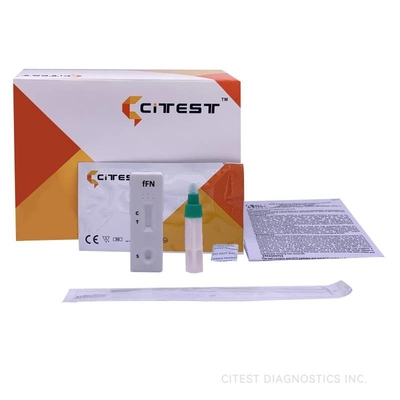

Fetal Fibronectin (fFN) Rapid Test,,CE fetal fibronection At Home Rapid Diagnostic Test Kits
| Principle | Chromatographic Immunoassay |
| Format | Cassette |
| Specimen | Vaginal Secretion |
| Certificate | CE |
| Reading Time | 10 minutes |
| Pack | 25 T |
| Storage Temperature | 2-30°C |
| Shelf Life | 2 Years |
| Sensitivity | 98.10% |
| Specificity | 98.70% |
| Accuracy | 98.40% |
| Cut-Off | / |
Applications:
The Fetal fibronectin (fFN) Rapid Test Cassette (vaginal secretion) is a visually interpreted, qualitative immunochromatographic test device for the detection of fFN in cervicovaginal secretions to be used as an aid to assess the risk of pre-term delivery during pregnancy.
The test is intended for professional use to help diagnose the rupture of fetal membranes (ROM) in pregnant women.
Description:
Fetal fibronectin (fFN), an isoform of fibronectin, is a complex adhesive glycoprotein with a molecular weight of approximately 500,000 daltons.
Fetal fibronectin is elevated in cervicovaginal secretions during the first 24 weeks of pregnancy but is diminished between 24 and 34 weeks in normal pregnancies.Detection of fFN in cervicovaginal secretions between 24 and 34 completed weeks gestation is reported to be associated with preterm delivery in symptomatic and asymptomatic pregnant women.
How to use?
Bring tests, specimens, buffer and/or controls to room temperature (15-30°C) before use.
1. Remove the test from its sealed pouch, and place it on a clean, level surface. Label the test with patient or control identification. To obtain a best result, the assay should be performed within one hour.
2. Add 2 drops (80 ul) of the extracted buffer into the sample well. As the test begins to work, you will see color move across the membrane.
3. Wait for the colored band to appear. The result should be read at 10 minutes. Do not interpret the result after 20 minutes.
![]()
INTERPRETATION OF RESULTS
![]()
NOTE:
1. The intensity of the color in test region (T) may vary depending on the concentration of aimed substances present in the specimen. Therefore, any shade of color in the test region should be considered positive. Besides, the substances level can not be
determined by this qualitative test.
2. Insufficient specimen volume, incorrect operation procedure, or performing expired tests are the most likely reasons for control band failure.